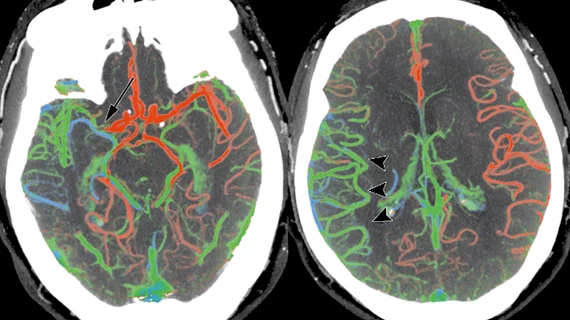Utilization of head CT perfusion (CTP) for imaging stroke patients spiked 428% between 2012 and 2019. Curiously, the uptrend was associated with higher mortality up to a year after discharge.
By comparison, MR angiography utilization fell 33%, yet—along with brain MRI (up 18%) and CT angiography (CTA, up 250%)—correlated with lower mortality.
So found researchers at Northwell Health who analyzed data on more than 85,500 Medicare records from patients 65 and older who were diagnosed with ischemic stroke either as hospital inpatients or in an emergency department. Prior to analyzing the figures, the team adjusted the data for potential confounders stemming from patient characteristics such as age, stroke severity and comorbidities.
The authors report their research in a study published online April 25 by the Journal of the American College of Radiology.
Jason Wang, PhD, Pina Sanelli, MD, MPH, and colleagues further observed CTA and CTP spurring greater use of two interventions—endovascular thrombectomy (EVT, which skyrocketed 688%) and intravenous thrombolysis (IVT). When deployed, these were associated with lower death rates.
Meanwhile the researchers found neuroimaging of all types lagging among Black, female and rural patients, as well as those aged 80 or over.
“Given these associations, understanding the root causes of the observed disparities is paramount to achieving equity in stroke care across the population,” the authors comment in their discussion. “The most striking disparity we found was that rural patients had significantly lower neuroimaging utilization than their urban counterparts, with the gap increasing over time for CTA and CTP from 2012 to 2019.”
They surmise the causes of this disparity may include closures of rural hospitals, underfunding, longer travel times for imaging and interventions, and “other factors that lead patients in rural communities to present outside the recommended treatment time windows.”
More:
The urban-rural disparity illustrated in our study has broader implications because previous studies have shown that low-income and marginalized populations are also more likely to seek care at low-volume hospitals. Many rural hospitals lack the angiographic equipment and personnel necessary to perform EVT procedures even if advanced CT imaging is performed. … Our findings suggest that lower utilization of CT-based neuroimaging may translate to lower utilization of acute stroke treatment. Whether these disparities impact acute stroke treatment utilization and clinical outcomes for disadvantaged groups warrants further study.”
Related Stroke Imaging Content:
FDA warns providers about potential misuse of imaging-based software for stroke triage
VA telestroke program prevents unnecessary hospital transfers and improves rural outcomes
Links to 20 new and revised American College of Radiology appropriate use criteria
Reference:
Jason Wang, PhD, Casey Pelzl, MPH, Artem Boltyenkov, PhD, Jeffrey Katz, MD, Jennifer Hemingway, MS, Eric Christensen, PhD, Elizabeth Rula, PhD, Pina Sanelli, MD, MPH. “Updated Trends, Disparities, and Clinical Impact of Neuroimaging Utilization in Ischemic Stroke in the Medicare Population: 2012 to 2019.” JACR, April 25, 2022. DOI: doi.org/10.1016/j.jacr.2022.03.008

